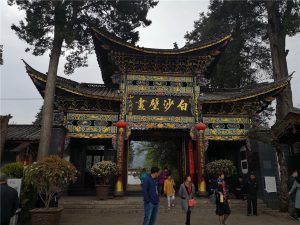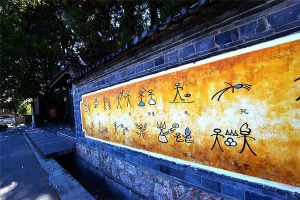
Baisha Murals in Lijiang
Chinese Name:白沙壁画
Chinese Pinyin Baisha Bi Hua
Keywords: Baisha Murals
Location: 10km north of Lijiang
Address: 8 km away north of Lijiang county
Opening Time: the whole day
Recommended Visiting Time: 1 day
Best Season to Travel: from July to September is the best season to travel
Why is Baisha Mural so special?
Located north of Lijiang Ancient Town, Baisha Village is the original settlement of the Naxi people, and the earliest cultural and political center of Lijiang. There, one of the most valuable treasures of Chinese painting – Baisha Murals (also known as Lijiang Murals) is kept and displayed in the old but splendid temples. Featured with unique religious subjects and superb painting skills, these murals serve as one of the important forms of Lijiang Dongba culture, and allure tourists who are intend to have an in-depth exploration of Lijiang to visit and admire.
Where is Baisha Mural?
Baisha Mural is located at Baisha Villages, 10km north of Lijiang. Although the traditional houses do not look impressive, this was the cradle of the Naxi culture and ancient capital of the Naxi Kingdom.
The valuable murals are protected inside Dabaoji Palace and the colored glaze temples. The originality and figures within the murals reflect the different religious cultures and artistic forms of Buddhism, Lamaism, Taoism and local Naxi Dongba religion’s development into Naxi School. Each painting includes at least one hundred portraits, which are not only Buddha, but also ordinary people such as bureaucrats, farmers, citizens and even criminals. Dominated by black, silver, dark green, gold and red colours, the murals in the back hall, overlaid with centuries of brown soot, are doomladen and bizarre. The scenes and figures, some still vivid in detail, are largely taken from Tibetan Buddhist iconography and include the wheel of life, judges of the underworld, the damned, titans and gods, Buddhas and bodhisattvas. Many of the scenes and subjects are drawn from people’s daily life showing fishing, riding horses, weaving, dancing and casting iron.
History of Baisha Mural
Baisha is 16 kilometers away from north of Lijiang city, Yunnan province, it is an ancient and beautiful town, is the original settlement of Naxi people in Lijiang dam, and also the birthplace of Lijiang Tusi Mu family, also the earliest Naxi political center. The famous “Lijiang Mural” is the product of the opening of Naxi society in Ming dynasty, it was painting from Ming to Qing dynasty, has lasted for over 300 years. Late Ming dynasty and the early Qing dynasty is the Lijiang mural boom period, more than five hundred years of history.
During the Ming dynasty, Lijiang Tusi Mu’s Family was in the heyday with political stability, economic prosperity, to show its rich, Mu’s Family built palaces, a batch of considerable scale buildings—existing Baisha colored glaze temple, Dabao palace and Dading pavilion were built during this period. The Ming dynasty murals stored in there is a very precious cultural relics, belong to national key cultural relics protection units. Dabao Palace has 558 existing murals, where stored the largest number of Lijiang Murals. Murals integrated of Han, Tibetan and Naxi culture and different religions in harmony as an organic whole, and Lijiang murals show the Tibetan Buddhism and Confucianism, Taoism and other life stories.

What are features of Baisha Murals?
Baisha Murals embodies the artistic characteristics of Naxi, Tibetan, Han and Bai ethnic groups, and absorbs all kinds of religious cultures (including Buddhism, Taoism and Confucianism) and art genres, to create a new harmonious artistic design. It is the reason why Baisha Mural is so precious and different among other frescos.
Combining the fine brushwork, rich colors and vivid patterns, it’s famed for its excellent Chinese traditional painting skills. In each painting, more than 100 characters were depicted with colorful ethnic styles and a strong local flavor to narrate the ancient tales. Many of the scenes are drawn from people’s daily life, presenting fishing, weaving, and dancing. Numerous wildlife and fascinating natural scenery like lotus flowers and running horses also enrich the painting, even including Sanskrit inscriptions.
These murals have witnessed the superb artistry, outstanding creativity and rich imaginations of the ancient people; they are not only the valuable treasures in the history of Chinese painting, but also the momentous cultural heritage serving as a dedicated ambassador who promotes Chinese culture to the world.
Baisha Ancient Town Accommodation
Baisha is the oldest and most primitive of the three ancient towns in Lijiang(other two are Lijiang Old Town and Shuhe Old Town). Recent years, there are many inns sprouting in the town, ranging from ordinary inns to high-end holiday clubs. Here we recommended some hotels and inns for your reference.
|
Name |
Add. |
|
Huamei Club Lijiang |
Near Baisha Murals |
|
Baisha Holiday Resort Lijiang |
No.33 Sanyuan Village |
|
Sunflower Inn |
No 9, Group 1,Sanyuan Villllage |
|
Lijiang Come Back Boutique Inn |
Community 1, Sanyuan Village |
Recommended Tour with Baisha Old Town
If you want to witness the authentic life of the Naxi People and appreciate their culture, but are tired of overcrowded Lijiang and Shuhe Ancient Town, then Baisha Old Town is the place to go. Here we have prepared some day tour packages with Baisha Old Town, as well as some Lijiang city tour packages and Yunnan Tour packages for your reference.

Travel Tips
The local festival is on the twelfth day of the first month of the lunar calendar. On this day, halls on the village’s east street will be open for sacrifices to the Gods and different people in Lijiang will gather in Baisha Village. If you are intrigued by the local traditional culture, the festival time is the best time to go.
Several cafes and many Naxi cuisine restaurants can easily be found at Baisha. The Here Restaurant serves western food and its pizzas are well-known.
Local explanations for the murals are rather limited, so you might like to gather information beforehand or hire a local guide if you wish to be fully informed about the murals.
Best Season to Travel: from July to September is the best season to travel, during that time the scenery is beautiful. The spring of Lijiang especially the melting season in the early spring is quite cold; summer is the most heated season, and it is also the rainy season; autumn is the most beautiful season in Lijiang, moderate temperature, fresh air, colorful trees and flowers; winter is the season with the low temperature and snow, the lowest temperature can be minus 20 degree.
Carry some woolens with you as the weather is quite cold – 3 to 25 degrees Celsius. Make sure that you get a list of good places to visit for food. If not, you need to get hold of a minimal supply of food at Lijiang City for your Baisha trip. Traditional Chinese food will be the most abundant.
Distances from Others Scenic Area:
• Lijiang Old Town: about 9.7 kilometers
• Jade Dragon Snow Mountain: about 16.6 kilometers
• Shuhe Old Town: about 4.4 kilometers
How to get to Baisha Village from Lijiang Old Town
1. Take bus 6 to People’s Government of Baisha Town.
2. Take a taxi straight to the village and the fare is CNY 40 or so.











